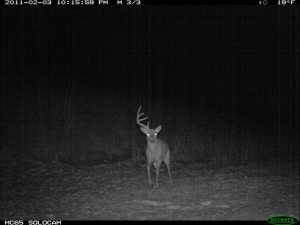Monitor a Herd’s Health by Shed Hunting
Filed under: Hunting Blog, White-tailed Deer
Monitoring a deer herd’s health is a critical part of deer management. One of the most enjoyable methods to get an indication of a herd’s health is by going shed hunting! Bucks that hold their antlers through January in most of the whitetails’ range are usually healthy. However, bucks that shed before mid January are usually stressed, injured, or have a disease.
Earlier this week Tracy (my wife) and her shed hunting lab (Crystal) searched several food plots for sheds. The next day Brad drove by one of those plots and saw the right antler from Hidden Valley 8 in plain view. It is very doubtful Tracy and Crystal would have missed that large (62”) shed. That gave me an exact date of when Hidden Valley 8 shed his right side. That’s obviously a rare event to know exactly when a free-ranging buck sheds.
 However, much data about when bucks shed can be easily collected by using trail cameras. The average date bucks of each age class shed can easily be calculated. Discovering that an individual buck shed early is not a reason for major concern. However, if a majority of the bucks have shed before January, the herd is experiencing significantly stress, probably due to malnutrition. If most of the bucks still have their antlers through most of January, the herd is probably in good health.
However, much data about when bucks shed can be easily collected by using trail cameras. The average date bucks of each age class shed can easily be calculated. Discovering that an individual buck shed early is not a reason for major concern. However, if a majority of the bucks have shed before January, the herd is experiencing significantly stress, probably due to malnutrition. If most of the bucks still have their antlers through most of January, the herd is probably in good health.
Images of an individual mature buck that shed early are often an indication he has been injured. Closer inspection of the trail camera images may allow determination of the location and extent of the injury.
It is fun to hunt an individual deer, but management of free-ranging herds is best when the entire population is considered. Evidence that a mature buck is injured is disheartening. Evidence that the entire herd is experiencing substantial stress is very concerning and should result in action.
Go shed hunting this week and investigate the health of the local deer herd!
Growing Deer together,
Grant



